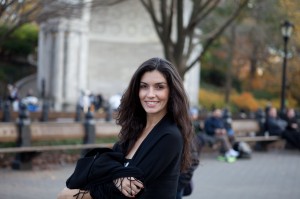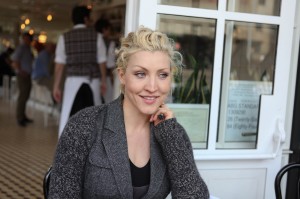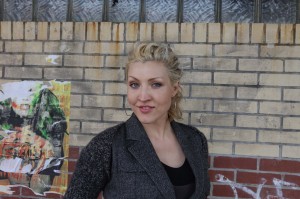By Maurice Pinzon
It is Sunday night, the city bracing itself for the upcoming work week, but at L’Orange Bleue in SoHo, the party is just about to start. The restaurant is anarchic as you enter. You cannot find anyone to seat you. But somehow, the space invites you to make your own personal space within. As the musicians set up against one end of the dark wood floor, encased by tropically-colored walls, nobody appears to have brought their dancing shoes. The crowd is dressed very “Sunday night casual” as you might expect them to be dressed if instead they were at home watching a television program.
Homera, a New York woman originally from Turkey, is having dinner with her husband. She has been coming regularly on Sunday nights for months. Three blonde-haired kids quietly sit with their French-speaking mother a few tables away. A big, bald-headed Latino man holds court at a round table with friends he has invited. The scents of the French-Moroccan food served by the restaurant start to waft over all of the casually-seated patrons.
The night is ready for Joyce Candido, a singer-songwriter from Brazil.
Although Ms. Candido’s first loves are samba and bossa nova, which she sings most other nights, Sunday is reserved for Forró, a regional music from northeastern Brazil. Forró groups often use a zabumba (a bass drum), an accordion, and a steel triangle. Ms. Candido has the triangle in her hand while she sings, accompanied by Michael Heller Chu, who plays the drum, strapped over his shoulder, and Olivier Glissant, folding and unfolding the accordion. Mr. Glissant formed the group called HiFi Forró and brought the three together about a year ago to play Forró at the restaurant on Sunday nights.
Before the performance, Ms. Candido promises the dance floor will be full once the regulars show up. But it doesn’t look that way, as only a few diners look over as she starts to sing. Ms. Candido improvises, focusing on the table with the children. The kids are shy when she goes over to them but within minutes she has enchanted them. The children, ranging in age from 4 to 11, are by her side as she sings, looking at her as if she were their muse.
This is but a prelude to a party for grow-ups.
As L’Orange Bleue begins to fill up, people slowly flock to the dance floor. Ms. Candido slowly releases her songs as if they were intoxicating liquor. Her beauty and sensuality wrap her performance with infectious energy. She sings, dances, laughs and flirts. People do not just watch, but participate in the party she has ignited.
During the intermission, Ms. Candido pollinates the crowd with her energy, moving from table to table to greet strangers and loyal followers who have become friends, showing up most Sundays to see her perform.
Imagine this taking place in a cool nightclub where there are never bouncers, booming sound systems, VIP rooms and the dress to impress crowd. Ms. Candido manages to bring together an eclectic group of Americans of all shades, along with Europeans, Middle-Easterners, Asians, Brazilians, Africans, and Latinos with roots from all over Latin America. They are all dancing in a kaleidoscope of color, their bodies close. The dancing is sensual, with hips undulating and legs intermingling, expressing a communal joy that only a prude would object to.
During a break in the performance, Siddique Essa said he tries to be at L’Orange Bleue at least every other Sunday. “We all come here because of her,” he said, meaning Ms. Candido, as she stood by his side. Mr. Essa insisted she has “the most amazing voice” and is also “a great dancer.”
And Ms. Candido did just that. As Mr. Heller Chu and Mr. Glissant played on, she danced with an expert dance partner. She twirled in her short blue skirt, her partner dipping her body parallel to the dance floor, her legs extended.
Later, Ms. Candido, standing next to musicians much taller than her, decided to jump on a chair as she continued to sing. Others picked up the tempo from her on the dance floor. The city was having fun the way it should, without press release or pretense.
In an earlier interview, Ms. Candido told the story of her journey to New York and spoke about her career aspirations. Ms. Candido has a following in New York that she has captured in a relatively short period of time. She arrived two and a half years ago, but first there were English and American dance classes to attend. She also taught dance briefly before turning full-time to her singing career.
Her excitement for New York started as a young girl growing up in Sao Paulo, Brazil. She dreamed of Broadway and wanted the challenge of succeeding in the city. She explained that any success abroad is highly respected in Brazil. In New York, Ms. Candido has found music and dance much more accessible than in her country, where she could never afford to take lessons with teachers of the caliber she has studied with in New York.
As she described it, it is as if you can just walk the streets of the city and grab what is out there, all the art, music and energy. “Everything you have here, it’s amazing,” she said.
She always had an interest in theater and music but she could never see them as separate. Ms. Candido hopes to one day be able to make use of her music education, her dance lessons and her singing and take her act to Broadway, where her songs and dance could all be integrated.
“My dream is to make a big show, where I can play the piano, sing and perform everything,” she said.
Although she is a singer-songwriter whose first CD was comprised mostly of her own songs, her upcoming CD, called “Old Fashioned, New Samba,” is mostly a compilation of well-known samba composers from Rio de Janeiro, where she recorded the songs. The CD will be released in the coming year.
Ms. Candido also sees herself as a bit of a cultural ambassador. She said, “I’m trying to get people to know the diversity of my country. I don’t want people to think that Brazil is just about samba, carnival, and beautiful women.”
“Yes,” she acknowledged, “there is that,” and “bad things,” but she insists there is so much more to her country and culture. There are many currents in Brazil she explained, coming from European, African and native Indian roots, that people in the U.S. know little about. There are also the classical music traditions such as the compositions of Villa Lobos.
She is one of the most beautiful Brazilian women you will ever meet. She is a musician who loves old and new samba, and bossa nova most of all, but who lights up any place singing and dancing Forró or perhaps just about any dance music. However, beyond her beauty and passion, is a grace, an understated sensuality she peels off just for you in her performances.
She sighed, pausing, as if it were a note, before answering the question of how she feels after a performance.
“Happy and tired,” she said.
“I try to give so much energy. I try to give people the best that I have in myself. Not just my voice, but my soul. I try to make people feel happy,” she said.
Ms. Candido will be singing at Esperanto on Sunday, December 5 at 7 pm and Wednesday, December 8 at 8:30 pm. She will be performing a repertoire of her own songs, and also classic bossa nova, samba and Brazilian jazz numbers. Esperanto is located at 145 Avenue C at the corner of 9th Street. For more information about Ms. Candido, you can visit her website at Joyce Candido.
See New York News Network’s slide show of Ms. Candido at Central Park and performing at L’Orange Bleue





